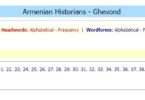ANOTHER LOOK AT MARR: THE NEW THEORY OF LANGUAGE AND HIS EARLY WORK ON ARMENIAN
Thomas J. Samuelian*
University of Pennsylvania
Medieval Armenian culture was the touchstone of Marr’s thought about language. It was the field of his apprenticeship and much of his later theorizing can be tied to problems he first encountered while studying Armenian culture, which was for him preeminently the culture of the middle ages-of Ani and Vardan Aygekc’i. Indeed, in every revision of his Japhetic or New Theory of Language the analysis of Armenian was the focal point or at least a crucial part of his presentation and evidence.
The linguistic controversy of 1950, Marr’s own exaggerations and follies, and the seemingly unattainable goal of a Marxist linguistics have obscured not only Marr’s theories, but also his early philological and archeological work. Recently, Marr’s work has been the object of renewed interest in the Soviet Union and abroad. A number of ideas Marr incorporated into his New Theory—notably, language mixture as a major process of language creation, and gesture as a precursor of spoken language-are, without reference to Marr, attracting many adherents in linguistics and anthropology.[1] Inasmuch as most of his work dealt explicitly or implicitly with Armenian, Armenian scholars, particularly those of the medieval period, are in an especially good position to understand his theory, its sources and its development.
Nikolaj Jakolevič Marr (1864-1934) is best remembered as the leading Soviet linguist of the twenties and thirties, whose New Theory of Language, raised to dogma during the anti-cosmopolitan reaction after World War II, was denounced by Stalin in Pravda in 1950. Marr was of course a scholar; but he was also an academic and political leader. He served as Dean of the Faculty of Social Sciences at Leningrad University, member of the Leningrad City Council, Director of the Leningrad Public Library, Founder and President of the State Academy of the History of Material Culture (GAIMK), Vice-President of the Academy of Sciences and member of the All-Russian Central Executive Committee, to name but a few of the most prominent posts he held during the early years of Soviet rule.
The “linguistic discussion” of 1950, during which Marr was denounced sixteen years after his death, “as the culmination of years of turmoil in linguistics. During the anti-cosmopolitan repression after World War II, Marr’s New Theory” was forcibly imposed by Stalinist authorities as part of the campaign for ideological purity. Opponents were reviled at academic meetings and in the press; many, including full members of the Academy of Sciences, were removed from their posts. Beginning on May 9, 1950 some two dozen linguists contributed articles to Pravda defending and denouncing Marr’s theory on linguistic and Marxist grounds. The Pravda discussion reached its climax on June 20th with Stalin’s “Concerning Marxism in Linguistics.” In this article he exposed Marr’s distortion of the Marxist category of class and put forth his own formulation of Marxist linguistics, which in turn was raised to dogma in all social sciences until well after his death in 1953.[2]
In the aftermath of the discussion, two volumes appeared under the title Against the Vulgarization and Distortion of Marxism in Linguistics. Among the forty some odd articles was one by I.K. Kusikjan. In the course of his refutation of Marrism, Kusikjan dropped a very suggestive line, which he chose not to pursue, since his purpose was not so much to explain Marr’s theory as to point out his deviations in the treatment of Armenian. It read:
One could say without fearing exaggeration, that a significant part of his [Marr’s—T.S.] general linguistic theory is founded, along with Georgian, on Armenian material.[3]
While I am loath to say that the material led the man, there are many questions to be answered about a theory which ran counter to the scientific consensus of its time. During the twenties and thirties many Western analysts pinned Marr’s excesses on the distorting influence of ideology. But even if the influence of ideology goes a long way to explain the conditions that made Marr’s ascendancy possible, it does not explain why Marr believed what he did long before he or Russia were Marxist. A close examination shows that, as Kusikjan hinted, the hunches, intuitions and impressions crucial to the full-blown New Theory of Language date to his early work on Armenian beginning in the 1890s.
Japhetidology, later the New Theory of Language, never had a formal or final formulation; therefore, in all fairness to Marr any systematic exposition of his ideas should be prefaced with at least a mention of his own consistently undogmatic stance.
Marr’s theory, as it stood at his death, can be derived from two not totally independent theses on language set against the background of historical materialism:
- language is a superstructural phenomenon,
- there is a unified process of language origin and growth; in Marr’s own words, a single glottogonistic process
Marr held that man first communicated by hand language and that spoken language is a later acquisition overlaid on it, as modern gestures vestigially show. Spoken language at first had a special magical or religious function in primitive society and was the possession of a special social group, as Grabar (Classical Armenian), had been the language of the church. Still later, national norms or standard national languages were the possession of the ruling elite in society. Marr concluded that from the very beginning language had been a class phenomenon.
Class differentiation is the hallmark of superstructural categories. Marx and Engels wrote in The German Ideology, which it should be noted, was not published until 1932, that “Language is the immediate actuality of thought.”[4] And just as thought or consciousness is a superstructural category, so too must language, its embodiment, be. Marx and Engels had shown that ultimately, superstructural phenomena change in response to the course of socioeconomic development, which they organized into a scheme of stages.
Language as a superstructural phenomenon must also develop through a corresponding course of stages: Marr’s single glottogonistic process. In principle, linguistic change was the response to social change as reflected in thought and thereby in linguistic structure. On this basis he distinguished three fundamental morphological types with a variety of transitional types: (1) amorphic, (2) agglutinative, (3) inflectional. The method of study was linguistic paleontology or the four-element analysis (SAL, ION, BER, ROŠ), the most notorious of Marr’s creations. The elements were supposed to have arisen from the first diffuse syllables of magical spoken speech incanted to the tribal totem. The process of language change was mixture, which Marr understood to be the free intermingling of elements from various languages. The transition from stage to stage, as with the socioeconomic stages of historical materialism, was by way of revolutionary leaps.
At the time of Marr’s death, a leading Marxist theorist, A. M. Deborin found in Marr’s theory a number of features which commended it as Marxist: (1) its all-embracing scheme of linguistic development, (2) the union of language and thought and their mutual dependence on social change, (3) the union of opposites in the meaning of primitive words, (4) the denial of any scientific basis for Fascism or racism and finally, (5) the treatment of language as a superstructural category. In all, he wrote “Marr’s Theory of Language confirms the correctness of Marxism-Leninism in all its parts.”[5]
According to Academician Jahukian, a Soviet Armenian historian of linguistics currently serving as the director of the Institute of Language in Erevan, whatever else linguistics may have believed about Marr’s theory, the thesis that language was a superstructural phenomenon was virtually unquestioned during the period from 1934-50.[6] This is worth remembering since this thesis was the central issue of the controversy in 1950 and the pretext for Stalin’s intervention in the role of the leading authority on Marxism-Leninism in the Soviet Union.
As Deborin’s comments indicate, Marr’s ideas had an independent source; the theory was a Marxist doublet. Marr’s success lay in coming upon ideas which coincided with Marxism and in so doing provided independent proof of Marxism’s truth.
Long before the revolution Marr had formed very strong opinions about the unified study of language and culture. This unified approach provided the basis for his conclusion that language is a superstructural phenomenon. As a graduate student Marr had been a philologist of Veselovskian persuasion. In a retrospective address at his alma mater, renamed Leningrad State University, he credited Veselovskij, the central figure in Russia’s journey into universal and holistic cultural and literary history, with having imbued the “atmosphere” with the ideas which inspired the New Theory. Nevertheless, as Marr’s biographer Mixankova relates, Marr, who on his appointment was seen as Veselovskij’s representative in Eastern languages and literatures, came to reject Veselovskij’s theory of wandering themes because “tracing the varied and multifaceted ties of themes with fables of other languages failed to explain their meaning in the history of Armenian literature as such, and by this type of analysis the themes are made anonymous and torn from their concrete historical circumstances.”[7]
Marr used similar argumentation in his contributions to several Armenian controversies of his day. To the literary critics who questioned the authenticity of the classical historian Xorenac’i, he responded that all considerations of Xorenac’i’s priority aside, his word had to be considered not only in relation to other texts, but also in its “real,” “living,” national context.[8] Similarly, Marr rejected Strzygowski’s claims for the influence of Armenian architecture on the West because “in basing his claims on formal analysis” Strzygowski had “failed to take into account the immediate sources and ties of Armenian architecture to its neighbors and historical-cultural context.”[9] Another reason Marr is said to have reacted to Strzygowski in this way was that he saw European interest in Armenian things as patronizing, and he openly disliked anything which would fuel Armenian national pride or aggravate Armenian-Georgian relations. Throughout his life, Marr was the target of much national prejudice both from Georgians who found their compatriot’s interest in Armenian things unseemly and from Armenians who resented his Georgian descent.”[10]
As these two instances show, Marr had a penchant for abstract, methodological refutation, which would serve him well in promoting and defending his own theory in the Soviet period. More importantly, they show his commitment to the unified study of all aspects of culture, which was recognized in a grand gesture by Lenin, who entrusted Marr with the trailblazing Academy of the History of Material Culture in 1919.[11]
Advocacy of the unified study of culture is still a step away from the thesis that language is a superstructural phenomenon. What was missing is the notion that class struggle is reflected in culture. Marr first stated this belief in two of his best-known Armenian studies. In his Master’s thesis on Vardan Aygekc’I’s parables, published in 1899, Marr wrote of the struggle between the feudal classes and the new bourgeois trading class as depicted in the parables.[12] Similarly, in explaining the fall of Ani, he emphasized the role of internal struggle, not external foes.[13] In 1933, looking back over his early research, Marr made the following link between material culture as a class phenomenon and language as a class phenomenon:
I studied the medieval Armenian language of Vardan’s Parables, which is a combination of two diverging and opposed social tendencies-the feudal and the bourgeois. This opposition finds its expression in architecture and literature of the corresponding social class, but their seeming juncture responds directly to the demands of the petit bourgeois class of the urban population with its guild organization, which on the whole constituted the makeup of any city of this period, especially Ani in the thirteenth and fourteenth centuries.[14]
During his excavations at Ani Marr came into contact with spoken Armenian. He later construed the difference between Modern and Classical Armenian to be one of class struggle as well. Some say that Marr was misled into this belief under the influence of the nineteenth-century populist movement to replace Classical Armenian-by then a language used predominantly by the clergy-with the vernacular or Modern Armenian language.[15] Marr projected the classical-vernacular struggle back into the middle ages and earlier:
It warrants repeating that at one time the vernacular and now living Armenian language, which lies at the base of the modern Armenian literary language is a special language, distinguished from the other Armenian, the princely language, the living language of the Armenian feudal lords, which lies at the foundation of the literary language of Ancient Armenia.[16]
He called Classical Armenian k-Armenian and Modern Armenian r-Armenian after the predominant plural marker in each language.
Thus, he came to the conclusion that language reflected class distinctions or more generally that language was a class phenomenon.
Had Marr at this point been a historical materialist, this thesis would have been a self-sufficient source for the New Theory. What his belief in linguistic class struggle lacked was a principle of progress or a scheme of developmental stages such as historical materialism provides. Marr was by his own admission not a historical materialist even as late as 1927.[17] But in time he did come upon a unifying principle for his observations on the development of Armenian and other languages.
One of the first things that struck Marr about Armenian and his native Georgian was that
Armenian in its significant, most characteristic part, especially in phonetics, lexicon and word-building, belongs to one common language family with Georgian, provisionally called Japhetic, and since the Japhetic family is related to the Semitic, the aforementioned most ancient part of the Armenian language is related to Semitic. Popular forms preserved for us in Vardan’s parables, provide a good many facts supporting this idea.[18]
Next, he turned to literary ties moving freely from literature to language. “The layering in literature could not but be reflected in language,” he writes.[19] Having established much that was common between Armenian and Georgian folklore, Marr wanted to explain these similarities not merely by the proximity of Armenians and Georgians. “The linguistic tie between the Georgian and the pre-Aryan layer of Armenian, has become clearer and clearer to me. It gives us the basis to propose that the shared motifs in oral literatures of these peoples dates to an era, when the Armenians and Georgians composed related nationalities . . .”[20]
In search of a cause for the similarities he found, Marr chose the most widely accepted linguistic explanation-genetic relation. By casting his account in terms of a common source instead of borrowing or cultural diffusion, Marr made a fateful choice. When he was accused of misusing the historical comparative method, which is based on genetic relations,[21] he stood by his observations and retorted that any method which failed to account for his observations was flawed and should either be revised to include them as he had done or totally abandoned, as he later would do. Marr’s European critics were adamant that revision was out of the question because Marr’s observations were of a kind unsuited to the comparative method. Their criticism was translated to mean that Marr’s observations were unscientific or false. Marr’s break with the historical comparative method was further abetted by a sense of stagnation in historical linguistics at the turn of the century and Marr’s animosity toward such figures as Hübschmann which dated to his student days in Strassburg.[22] From this point on Marr was more expansive in his theorizing. In his 1903 Grammar of Classical Armenian he stated definitively that Armenian was bigenetic.
The Armenian language is even now an unsolved riddle for scholars. One thing is clear, it is a highly characteristic example of a mixed language. Of course, I am not speaking here of the rich admixture of obviously borrowed words, easily distinguished and to a significant extent already separated out. I have in mind the core of the real Armenian language, which arose on the soil of historical Armenia. This core itself is bigenetic.[23]
Japhetic, that tie between Armenian and Georgian, was gradually transformed from an ancient source to a product of similar social conditions. The crucial step came when Marr declared that “architectural monuments, arising in different class environments of the Armenian nation, exhibit fewer traits in common than monuments arising in the same social conditions of different people, such as the Georgians and Armenians.”[24]
He had by then rejected the possibility of a common source as an explanation for the similarities he found. What remained was explanation by independent invention; similarities being attributable to the similarity in the conditions which engendered them.
This statement about architecture he gradually extended to other aspects of culture in the form of a principle that cultures arising from the same social conditions or standing at the same stage of social development have more in common than any single culture has with its predecessors or successors. Twenty years later this idea would find forceful expression in the Stalinist formula, “National in form, socialist in content.”
Thus, Marr the Armenian philologist, had in his own uncanny way stumbled upon a position which came very close to Marxism some twenty years before Marx and Engels1 most explicit statements on the nature of language.[25] The central theses of Japhetidology, later called the New Theory of Language, were, therefore, present and operating some twenty years before the revolution.
In due course Marr embellished his theory with many of the concepts current in nineteenth- and early twentieth-century linguistics. Early in the nineteenth century Humboldt, the Schlegel’s, Bopp and others believed that languages develop through three stages distinguished by morphological type. Each stage is to reflect a stage in man’s mental development.[26] Marr, under the influence of this concept and more current work on primitive thought and language by Lévy-Bruhl, consolidated his grand theory of cultural, mental, and linguistic development.[27] Extending the theory to yet earlier times, Marr proposed a period of gestural or hand language, which was gradually supplanted, but never totally replaced by spoken language. In the late nineteenth century, the hand-language hypothesis had been put forth by several anthropologists, most prominently, Ludwig Noire and Frank Cushing, on whom Marr relied.[28]
In the Soviet period the transformation of Japhetidology into the New Theory of Language was not so much a reworking of his ideas in the Marxist framework as a recognition of their kinship with certain Marxist categories and values. The New Theory, announced in 1924, was in no way new. It was simply the continuation of the Japhetic theory. In fact, Marr did not adopt a consciously Marxist idiom until his Baku course of 1927.[29]
His opposition to Western linguistics did, however, grow more and more strident until on November 23, 1923 he made his final break with Indo-European linguistics. At the meeting of the Academy of Sciences he reported that
The Indo-European languages of the Mediterranean never were a special racial family of languages nor did they (the Indo-Europeans) come from any place with some special linguistic material. Even less do they go back to any racially special proto-language. In fact, in the beginning, there was not one, but a plurality of tribal languages; a single proto-language is a scientific fiction which has outlived its usefulness.[30]
The Indo-European languages had become for Marr little more than a stage of greater linguistic complexity. This complexity was the result of the linguistic mixture which had taken place during the revolution in social conditions associated with certain new forms of production. These new forms of production were, in turn, called forth by the discovery of metals and their widespread use in the economy. “The Indo-European family of languages typologically is the creation of new economic conditions, but its material is vestigial and its inner construction shows it to be the later stage of all the Japhetic languages of the Mediterranean.”[31]
This new conception of the relation of the Indo-European languages to the Japhetic languages called for revisions in the treatment of Armenian as well.
The Armenian and, to an extent, the Albanian languages are not mixtures of the Indo-European languages and Japhetic languages [which are in fact different stages of the same language] but are in transition between Japhetic and completely Indo-European.[32]
By 1925 Marr’s theory was well on its way to governmental endorsement. Marr himself had emerged as a trusted public servant and an academician with an institutional domain extending from Leningrad to Baku. There were by then two institutions—the Daphetic Institute of the Academy of Sciences and the State Academy of the History of Material Culture (GAIMK)—inspired by his theory and devoted to his line of research on a large scale. Marr, cast out by Western linguistics, had gained influence and even acclaim at home. By 1925 Lunačarskij, the Commissar of Education, could write in Izvestija, “The idea of the Academy of Material Culture arose in the fecund mind of the great philologist of our Union, and perhaps the greatest living philologist of our time, N. Ja. Marr.”[33]
In the last ten years of his life Marr turned from the study of particular languages to Language in general. His work on Armenian never really ended, but it became less significant in its relative volume and impact. The call for Marxist science was sounded louder and more frequently in those years, and Marr from his position of prominence in Soviet scientific and political life was naturally looked to for leadership in the search for a Marxist linguistics. A struggle ensued, which was as much a part of the bolshevization of the Academy of Sciences and the terror of the late twenties as the scientific ferment in linguistics. Marr, being in a position of power, was not easily discredited or displaced. Just when Marr, ailing and tired of being under fire, was ready to withdraw from the linguistics scene, he was reaffirmed by the Communist Academy as the undisputed authority on Marxism in Linguistics. As a conversation, recorded in the memoirs of one of his students, I. A. Orbeli, shows, it was an accolade Marr would rather not have received.[34] What resulted was a theory, never meant to be adopted as doctrine, being confirmed as a nearly final truth over the qualms of its creator.
Marr’s theory was not nearly so unique as it was made out to be by either his supporters or his critics. His programs echoed those of many of his contemporaries and predecessors—a fact which lent support and credibility to his criticism of the West. His image as a dissenter, an underdog, and a renegade all captivated his Soviet audience. That image combined with his Georgian descent contributed greatly to the favor he enjoyed in the eyes of political leaders who found in him a suitable appointment, symbolic of a new regime pledged to the eradication of Great Russian oppression.
As for the concrete linguistic work itself, while it may be intriguing to unravel the intricate web Marr spun out of the languages he saved from obscurity, the beliefs themselves should not be so readily dismissed. One has to pause, in light of recent developments in socio and ethno-linguistics to appreciate how enlightening such perspectives on language could be if used with measure and skill. Current interest in the social stratification of language, creolization, the study of language in context and language policy touch upon some of the beliefs and directions of Marr’s work. Notable among those encountered in his early work on Armenian are:
- language mixture as a major process of language change and genesis
- and conversely, the rejection of the supremacy of genetic relations
- differentiation of language by function and class
- attraction to universal schemes of linguistic development especially typological
That the concrete analyses did not in any way correspond to reality was beside the point. They provided an account of the material which supported the desired conclusions, and the spinning of the web gives the appearance of science in the viewing and the pleasure of puzzling together linguistic data in the making. If it had matched reality, so much the better, or as Marr would say in 1925,
My students tell me (and for that matter non-students acquainted with Japhetic linguistics as well), that in fact I confirm the premises of Marxism. I will not argue if this is so; but Japhetic linguistics is not Marxism any more than it is a theoretical construct. Now if in it there are premises which support the Marxist doctrine, then, from my point of view, so much the better for it and the worse for its opponents, since in reality linguistic facts do not permit the questioning of the premises of Japhetic linguistics.[35]
Those facts, by and large, were Armenian facts.
* T. Samuelian & M. Stone, eds. Medieval Armenian Culture. (University of Pennsylvania Armenian Texts and Studies 6). Chico, CA: Scholars Press, 1983. pp. 203 to 217.
[1] V. V. Ivanov, Očerki po Istorii Semiotiki v SSSR (Moscow: Nauka, 1976) brought to light a number of recent studies which adopt Marr’s positions without reference to him. See K. Hill, ed. The Genesis of Language (Ann Arbor: Karoma Publishers, 1979); J. Hill, “On the Evolutionary Foundations of Language,” American Anthropologist 74(1972) 3:308-317; G. Hewes, “Primate Communication and the Gestural Origin of Language,” Current Anthropology 14(1973) 1-2:5-24. On another of Marr’s pet ideas—the development of articulated language from amorphous religious chant—see Bruce Richman, “Did Human Speech Originate in Coordinated Vocal Music?” Semiotica 32(1982) 3-4. Western reaction to Ivanov’s book is a good gauge of how deep a scar Marrism left on linguistics around the world, see A. V. Isafenko, “Marr—Redivivus?” Russian Linguistics 4(1978) 1:83-87; D. Laferriere, “Semiotica sub Specie Sovietica: Anti-Freudianism, Pro-Marrism and other Disturbing Matters,” PTL 3(1978) 437-54.
[2] For English translations of the articles which appeared as part of the Linguistic Discussion see the collection by V. Murra, M. Hankin & F. Holling, The Soviet Linguistic Controversy (NY: King’s Crown Press, 1951). See also the June 1977 issue of Langages (ed. J. B. Marcellesi). The entire issue is devoted to “Langage et classes sociales: le Marrisme” and includes a chronicle of events.
[3] I, K. Kusikjan, “Ošibki N. Ja. Marra v osveščenii istorii armjanskogo jazyka,” 2:426-446 in V. V. Vinogradov 4 B. A. Serebrennikov (eds.), Protiv Vul’garizacii i Izvraščcenija Marksizma v Jazykoznanii (2 vols., Moscow: AN SSSR, 1951-52) 429.
[4] K. Marx & F. Engels, The German Ideology, Pt. I (ed. C. J. Arthur; NY: International Publishing, 1978) 118.
[5] A. M. Deborin, “Marksizm i Učenie Marra o Jazyke i Myšlenii,” Vestnik Akademii Nauk (1935) 4:25-40; Deborin, “Novoe Ucenie o Jazyke i Dialektičeskij Materializm,” 21-75 in XLX Akademiku N. Ja. Marru (Moscow-Leningrad: AN SSSR, 1938) 21; Deborin, “Genial’nyj Lingvist,” Izvestija C1K SSSR 21 Dec. 1934 [Reprinted in Problemy Istorii Dokapitalističeskogo Obščestva (1935) 3-4:200-201.
[6] G. Ĵahukyan, Lezvabanut’yan Patmut’yun (2 vols. Erevan: Erevan Hamalsarani Hrat., 1960-62) 2:434.
[7] On Marr and Veselovskij see N. Ja. Marr, “Jafetidologija v Lenin gradskom Universitete,” 1:254-272 in his Izbrannye Raboty (Leningrad: GAIMK, 1933) 271; V. F. Šišmarev, “N. Ja. Marr i A. N. Veselovskij,” Jazyk i Myšlenie 8(1937) 321-339; V. A. Mixankova, Nikolai Jakovlevič Marr (Moscow-Leningrad: AN SSSR, 19*8), 62.
[8] Mixankova, Marr, 67.
[9] lbid., 143.
[10] Marr, Ani: Knižnaja istorija goroda i raskopki na meste gorodišča (Izv. GAIMK 105; Moscow-Leningrad, 1935). Although published posthumously, this book is composed of Marr’s course notes on Ani dating to 1910-1912 and represents, with the exception of the introduction which was written shortly before his death, his thinking in the pre-revolutionary period. See also A. Movsisyan, N. Ya. Mari Kyank’ĕ ev Stełcagorcut’yunĕ (Erevan: HSSR GA Hrat, 1946) 8.
[11] Mixankova, Marr, 249.
[12] Marr, Sborniki Pritč Vardana (St. Petersburg, 1899) as quoted in Mixankova, Marr, 90-91, 186. See also M. Abetyan, Hayoc’ Hin Grakanutyan Patmut’yun (2 vols.; Erevan: HSSR GA Hrat., 1946) 2:169-172.
[13] Marr, Ani, vi.
[14] Marr, “Doistorija, Preistorija, Istorija i Myšlenie,” Izv. GAIMK 74(1933) 19.
[15] Kusikyan, “Ošibki Marra,” 429; L. Thomas, The Linguistic Theories of N. Ja. Marr (Berkeley & Los Angeles: U. of CA, 1957) 25.
[16] Marr, “O Čanskom Jazyke” (1910) 1:39-49 in his Izbrannye Raboty (Moscow-Leningrad, 1933) 39. It is generally held that Modern Armenian is a descendant of the classical language, which was first committed to writing in the fifth century. Marr, on the contrary, believed that the two languages had distinct sources or at least a different proportion of these sources in their makeup. In Modern Armenian, the Japhetic elements native to Eastern Anatolia and the Caucasus were predominant and in Classical Armenian, the Indo-European or Aryan elements. Later, when Marr rejected the notion of the Indo-European family altogether, the mixture hypothesis became meaningless and he proposed that Armenian was caught between the Japhetic and the Indo-European stages of linguistic development. Modern Armenian, therefore, was more archaic than Classical Armenian. On Marr’s interest in archaism in living languages see Mixankova, Marr, 104.
[17] Mixankova, Marr, 338.
[18] Marr as quoted in ibid., 83.
[19] Ibid., 255.
[20] Ibid., 91.
[21] The central premise of the comparative method is that recurrent correspondences of comparable linguistic units (usually phonemes) in two or more languages indicate that those languages have a common source. To attribute these either to coincidence or massive, identical borrowing defies the laws of probability, on which see E. D. Polivanov, “Even Mathematics can be Useful,” 226-272 in his Selected Works (ed. A. Leontiev; trans. D. Armstrong; The Hague: Mouton, 1974). Conversely, languages which are related display recurrent correspondences. Marr’s correspondences are by comparison sporadic and idiosyncratic for each word. It is not that languages could not in some possible world develop as Marr portrayed it in his work, but that they do not is the great empirical finding of nineteenth-century linguistics.
[22] Mixankova, Marr, 37. On the sense of stagnation in historical linguistics at the turn of the century see Hans Aarsleff, “Bréal vs. Schleicher: Linguistics and philology during the latter half of the nineteenth century,” 62-106 in H. Hoenigswald, ed., The European Background of American Linguistics, Dordrecht, Holland: Foris Publications, 1979.
[23] Marr, Grammatika Drevnearmjanskogo Jazyka (St. Petersburg: Imperatorskaja Akademija Nauk, 1903) xxxi.
[24] Marr, Ani, 123.
[25] The German Ideology, in which Marx and Engels expounded the unity of language and thought, the cornerstone of Marxist linguistics, was not published until 1932 by the Institute of Marxism-Leninism in Moscow, two years before Marr died.
[26] Wilhelm von Humboldt, Linguistic Variability and Intellectual Development (trans. G. Buck & F. Raven; Philadelphia: U. of PA, 1972) 5, 131.
[27] Marr refers to Lévy-Bruhl for his ideas on pre-logical thought and polysematicity of primitive language. Relevant passages from Lévy-Bruhl’s work can be found in J. Cazeneuve, Lucien Lévy-Bruhl (Paris: Presses Universitaires de France, 1963) 30, 34, 56.
[28] Marr, “O Proisxozdenii Jazyka,” 286-337 in Po Ètapam Razvitii Jafetičeskoj Teorii [PERJT] (Moscow-Leningrad: Naučno-Issledovatel’skij Institut Etničeskix i Nacional’nyx Kul’tur Narodov Vostoka SS5R, 1926) 320; L. Noire, On the Origin of Language (2nd ed.; Chicago: Open Court Publishing, 1898); F. H. Cushing, “Manual Concepts: a study of the influences of hand-language on culture growth,” American Anthropologist 5(1892) 4:289-317. For recent interest in this hypothesis see n. I above.
[29] Marr, “Jafetičeskaja Teorija” (1927) 2:3-135 in his Izbrannye Raboty (Moscow-Leningrad: Gos. Soc-Ekonomičeskoe Izd., 1936).
[30] Marr, Indoevropejskie Jaziki Sredizemnemor’ja (1924) 244-245 in Po Ètapam Razvitii Jafetičeskoj Teorii [PERJT] (Moscow-Leningrad, 1926), 244-245.
[31] Ibid.
[32] Ibid.
[33] A. Lunačarskij, “Materializm i Filologija,” Izvestija CIK SSSR 12 Apr. 1925.
[34] I. A. Orbeli as quoted in A. Leontiev, L. I Rojzenzon 4 A. D. Xajutin, “The Life and Activities of E. D. Polivanov,” 11-31 in E. D. Polivanov, Selected Works (trans. D. Armstrong; The Hague: Mouton, 1974).
[35] Marr, “Osnovnye Dostiženija Jafetičeskoj Teorii,” 246-257 in PERJT 249.







